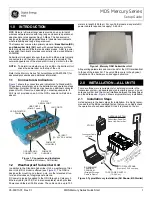
14
PCM/ DOLBY DIGITAL
/ DTS
DIGITAL OUT
DIGITAL IN
DIGITAL 1 (DVD)
DIGITAL 2 (CD)
DIGITAL 3 (TV)
DIGITAL 4 (CDR)
Digital connections
This receiver is equipped with four DIGITAL IN terminals on the
rear panel—one digital coaxial terminal and three digital optical
terminals—and one DIGITAL OUT (optical) terminal on the rear
panel. Another digital optical input terminal is located on the front
panel (see page 11).
IMPORTANT:
• When connecting video components using the digital terminals, you
also need to connect it to the video jacks on the rear panel.
Otherwise, you cannot view any playback picture.
• After connecting the components using the DIGITAL IN terminals,
set the following correctly if necessary.
– Set the digital input (DIGITAL IN) terminal setting correctly. For details,
see “Setting the digital input terminals” on pages 37.
– Select the digital input mode correctly. For details, see “Selecting
the Analog or Digital Input Mode” on page 22.
Digital input terminals
You can connect any digital components having coaxial or optical
digital output terminal.
Notes:
• When shipped from the factory, the DIGITAL IN terminals have
been set for use with the following components:
– DIGITAL 1 (coaxial): For DVD player
– DIGITAL 2 (optical): For CD player
– DIGITAL 3 (optical): For digital TV broadcast tuner
– DIGITAL 4 (optical): For CD recorder
• When you want to operate a CD player, a CD recorder, and/or an
MD recorder using the COMPULINK remote control system (see
page 51), connect the target components with both digital and
analog connections (see pages 10 and 11).
• When you want to operate a DVD player, a VCR, and/or a TV using
the AV COMPULINK remote control system (see page 53), connect
the target components with both digital and analog connections
(see pages 12 and 13).
Digital coaxial cable (not supplied)
between digital coaxial terminals
Digital optical cable (not supplied)
between digital optical terminals
Before connecting a digital
optical cable, unplug the
protective plug.
When the component has a digital
optical output terminal, connect it to the
DIGITAL 2 (CD), DIGITAL 3 (TV) or
DIGITAL 4 (CDR) terminal, using a
digital optical cable (not supplied).
When the component has a digital
coaxial output terminal, connect it to
the DIGITAL 1 (DVD) terminal, using a
digital coaxial cable (not supplied).
Digital output terminal
You can connect any digital components which have an optical
digital input terminal.
Note:
The digital signal format transmitted through the DIGITAL OUT
terminal is the same as that of the input signal. This means that when
the DTS signals are input, the DTS signals are transmitted.
When the digital recording
equipment such as a CD recorder
has a digital optical input terminal,
connecting it to the DIGITAL OUT
terminal enables you to perform
digital-to-digital recording.
Digital optical cable (not supplied)
between digital optical terminals
Connecting the RF Rod Antenna and
IR Signal Transmitter
The combination of the RF rod antenna and the IR signal transmitter
allows you to use the multi-room function more conveniently.
The remote control supplied with this receiver can transmit both RF
and IR signal at the same time. This receiver catches the RF signals
emitted from the remote control, and converts them into IR signals,
then transmits the converted signals to the remote sensors on the
other components through the IR signal transmitter.
This means that you can control not only this receiver but also other
components from Zone 2.
Setting up the RF rod antenna
The remote control supplied with this receiver can transmit RF
(Radio Frequency) signals as well as IR (infrared) signals. The RF
rod antenna can receive the RF signals emitted from the remote
control. So, with the RF rod antenna connected, you can operate the
receiver at a distance of up to 15 m (50 feet) using RF signals sent
from this receiver (more than twice as far as when using IR signals).
Moreover, RF signals can go through walls and other objects in the
house so you need not aim at the receiver directly.
However, if the antenna cannot receive signals stably, you cannot
operate the receiver correctly.
• Without the RF rod antenna connected, you can operate the
receiver with the remote control, aiming the remote control
directly at the remote sensor on the receiver.
1. Insert the RF rod antenna onto the RF REMOTE
ANTENNA terminal.
2. Rotate the fixing nut to attach the RF rod
antenna firmly.
1
2
RF REMOTE
ANTENNA
IR OUT
RF REMOTE
ANTENNA
IR OUT
1-15_8040[J]_D.p65
04.4.21, 11:52
14
















































